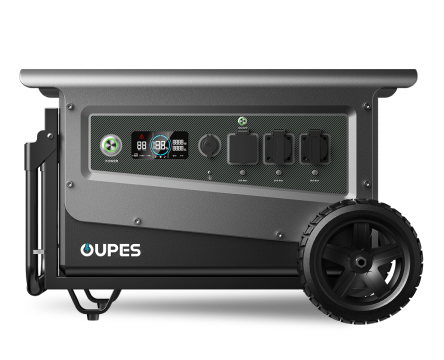
- TL;DR / Key Takeaways
- Overview: Solar Panel Power Output Explained
- Rated Wattage vs. Real-World Output
- Key Factors That Affect Solar Panel Output
- Daily, Monthly & Annual Energy Production
- Solar Panel Types & Their Efficiency
- Power Generation for Portable Power Stations
- Comparison Table: Output at Different Conditions
- FAQ
TL;DR / Key Takeaways
- A solar panel’s watt rating (e.g., 100W, 240W, 400W) reflects its output under ideal lab conditions, not real-world use.
- Real-world output is usually 70–90% of rated power due to temperature, angle, shading, and environmental factors.
- Daily energy production depends heavily on average sun hours; for example, a 200W panel may yield 600–900Wh per day.
- NREL reports that U.S. average sun hours range from ~3 (northern states) to 6.5+ (southwestern states).
- Portable solar generators, such as OUPES power stations, rely on accurate solar sizing to achieve full daily recharging.
Overview: Solar Panel Power Output Explained
Solar panels generate electricity by converting sunlight into usable DC power. This output is measured in watts (W) at any moment, and watt-hours (Wh) over time. When people ask, “How much power does a solar panel generate?” they usually want to know:
- How many watts a panel can produce at peak sun
- How many watt-hours per day it can actually generate
- How solar output varies with environmental conditions
Understanding these details is crucial for anyone using solar with portable power stations, off-grid cabins, RVs, and emergency backup systems.
Rated Wattage vs. Real-World Output
What Is “Rated Wattage”?
Solar panels are tested under STC—Standard Test Conditions—which assume:
- 1000 W/m² solar irradiance
- 25°C panel temperature
- Perfect angle & no shading
These conditions almost never occur in real life, so real output is lower.
Typical Real-World Output Efficiency
Under normal conditions, a solar panel produces:
- 70–90% of its rated wattage in full sun
- Varies throughout the day as sunlight intensity changes
Examples
- A 100W panel may generate 70–90W in good real-world sun
- A 240W panel may produce 170–220W under typical use
Key Factors That Affect Solar Panel Output
1. Sunlight Hours (Peak Sun Hours)
Peak sun hours represent the amount of solar energy available each day. According to NREL solar maps:
- Northern U.S.: 3–4 hours/day
- Central U.S.: 4–5 hours/day
- Southwestern U.S.: 6–7+ hours/day
2. Panel Angle & Orientation
To maximize output:
- Face panels south (Northern Hemisphere)
- Tilt angle ≈ your latitude for year-round use
3. Heat (Temperature Loss)
Solar panels lose efficiency as they heat up. High temperatures commonly reduce output by 10–20%.
4. Shading & Clouds
Even partial shading can dramatically reduce output—sometimes up to 80% depending on panel design.
5. Cleanliness (Dust, Snow, Debris)
Dirt and snow reduce light penetration. Dirty panels can lose 10–25% output depending on buildup.
6. System Losses
Losses include:
- Wiring loss (1–3%)
- Charge controller efficiency (5–10%)
- Panel aging (0.5–1% per year)
Daily, Monthly & Annual Energy Production
How to Calculate Daily Output
Daily Energy (Wh) = Panel Wattage × Sun Hours × Real-World Efficiency
Example: 200W panel with 5 sun hours
200W × 5 × 0.8 (80% efficiency) = 800 Wh per day
Estimated Daily Output by Panel Size
| Panel Wattage | Daily Output (Low Sun) | Daily Output (Average Sun) | Daily Output (High Sun) |
|---|---|---|---|
| 100W | 200–350 Wh | 350–500 Wh | 500–650 Wh |
| 240W | 450–700 Wh | 700–1100 Wh | 1100–1500 Wh |
| 400W | 800–1200 Wh | 1200–1800 Wh | 1800–2400 Wh |
Annual Energy Output
Example: 240W panel at 5 sun hours/day:
240W × 5 × 365 × 0.8 = ~350 kWh/year
Solar Panel Types & Their Efficiency
Monocrystalline Panels
Typically 18–23% efficient; best performance in low-light and high temperatures.
Polycrystalline Panels
15–18% efficiency; lower cost but reduced performance.
Portable Foldable Panels
Often used with solar generators; efficiency around 18–22%.
Portable panels like those used with OUPES systems offer the advantage of lightweight design, ease of deployment, and integration with MPPT charge controllers.
Power Generation for Portable Power Stations
Portable solar generators rely on pairing solar panels with a built-in battery system. Understanding solar output helps determine:
- How fast your power station can recharge
- How large a panel array you need
- Whether your setup can sustain off-grid use
Example: Charging a 2 kWh Power Station (like an OUPES mid-size model)
| Solar Input | Estimated Charge Time |
|---|---|
| 200W | 10–12 hours |
| 400W | 5–6 hours |
| 800W | 2.5–3 hours |
Why MPPT Matters
MPPT (Maximum Power Point Tracking) charge controllers increase solar harvest by 20–30% compared with PWM controllers, especially in variable lighting conditions.
Comparison Table: Output at Different Conditions
| Condition | Output of a 240W Panel | Realistic Percentage |
|---|---|---|
| Clear sky, optimal angle | 180–220W | 75–92% |
| Partly cloudy | 80–150W | 33–62% |
| Overcast | 20–60W | 8–25% |
| Heavy heat (35°C+) | 150–190W | 62–79% |
FAQ
1. Why does my panel not reach its rated wattage?
Rated wattage is measured under perfect lab conditions. Heat, angle, and atmospheric conditions reduce real output.
2. How many solar panels do I need to go off-grid?
It depends on daily energy consumption. A modest off-grid cabin may need 1–2 kWh/day, requiring 600–1200 W of panels. A full-size home needs significantly more.
3. Can portable panels power a refrigerator?
Yes, when paired with a solar generator. The panels recharge the battery, and the power station runs the appliance. Daily sun availability must support the load.
4. Are flexible or foldable panels less powerful?
Foldable portable panels often have similar efficiency to rigid panels but lower heat dissipation, which may reduce output in very hot conditions.
5. Does shading one cell affect the whole panel?
Yes. Partial shading can significantly reduce output. Panels with bypass diodes minimize the impact but cannot eliminate it entirely.




























